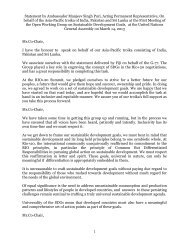STATE OF THE WORLD'S CITIES 2012/2013 Prosperity
STATE OF THE WORLD'S CITIES 2012/2013 Prosperity
STATE OF THE WORLD'S CITIES 2012/2013 Prosperity
Create successful ePaper yourself
Turn your PDF publications into a flip-book with our unique Google optimized e-Paper software.
State of the World’s Cities <strong>2012</strong>/<strong>2013</strong><br />
POLICy<br />
Cities that are committed to quality of life are almost<br />
always committed to enhanced productivity and equity,<br />
emphasizing the strong relation between these dimensions.<br />
development), but dividing the pie and ensuring that the<br />
poor benefit, too (i.e., equity and quality of life)”. 12 Dubai,<br />
as other cities in the Arab Gulf, recognizes quality of life as<br />
Box 2.3.1<br />
Quality of Life – the ‘Spokes’ and the ‘Hub’ of the Wheel of Urban <strong>Prosperity</strong><br />
Quality of life and productivity<br />
Productivity and quality of life are increasingly associated. Skilled<br />
workers and talented people will flock to, and concentrate in,<br />
liveable cities with high quality of life, and firms will follow suit.<br />
Consulting firms rank cities based on their ‘good living’ factors to<br />
make informed locational decisions. High human capital, which<br />
is a main ingredient of quality of life, attracts firms that cluster in<br />
cities to take advantage of common labour pools. Well-planned<br />
and designed urban environments, with pedestrian-friendly areas,<br />
bicycle paths, mix-land uses and sufficient public goods, attract<br />
people and businesses which, in turn, contribute to finance further<br />
social amenities and public goods. More and more city leaders<br />
are investing in education and the provision of ‘commons’ and<br />
public goods as part of a quality of life. Inversely, cities that do<br />
not invest in quality of life tend to feature poor public health, low<br />
education, limited mobility, and marginalization of the urban poor,<br />
all resulting in low productivity.<br />
Quality of life and infrastructure development<br />
The prosperity of a city largely depends on infrastructure.<br />
Physical facilities like transportation, power and communications<br />
contribute to economic development, industrialization, trade and<br />
mobility of labour. Water supply, sanitation and sewerage, together<br />
with education and health facilities, have a direct impact on<br />
quality of life. All of these types of infrastructure connect people<br />
to people, goods to markets, workers to jobs, families to services,<br />
and the poor in rural areas to urban centres − a connectivity<br />
process that is essential to induce economic growth, reduce<br />
poverty and increase general well-being. More and more cities<br />
today are launching into ambitious initiatives to expand/improve<br />
infrastructure to sustain economic growth, prepare for population<br />
decline, address climate change issues and/or reduce slum<br />
incidence. Conversely, under-developed infrastructure makes life<br />
more difficult and more costly: poor facilities discourage industrial<br />
development, trade and investment and reduce competitiveness,<br />
besides generating air pollution, wasted time, fuel and safety<br />
costs, noise and more greenhouse gas emissions.<br />
62<br />
a key competitive advantage that contributes to promoting<br />
city productivity, attracting and retaining highly qualified<br />
individuals and prestigious firms and investors. Priority is<br />
given to those most easily perceived elements of quality of<br />
life such as parks, clean sidewalks, leisure, art and culture<br />
amenities as well as hospitals. Although not generalized<br />
to all the population, the pursuit of prosperity through<br />
quality of life is an interesting connection and entry point<br />
to development.<br />
Quality of life and equity<br />
Quality of life and equity are constitutive of progress and<br />
development. No city can claim to be prosperous when large<br />
segments of its population are excluded or live in abject poverty,<br />
or when large sections of the population are deprived of basic<br />
goods or services while other sections live in affluence. Cities<br />
that look to more equity in the distribution of resources and<br />
opportunities, in law enforcement, in the rules and relationships<br />
that govern institutions and in access to public goods will be those<br />
where shared prosperity and quality of life are improved. More<br />
equitable cities enhance the prospects for people to take part in<br />
democratic processes and participate in a more decisive manner<br />
in cultural and political life. The benefits of social participation<br />
and political voice extend to other domains such as health,<br />
employment and the urban environment.<br />
Quality of Life and Environmental Sustainability<br />
Environmental conditions have an immediate impact on the<br />
quality of people’s lives. They affect human health both directly<br />
(air, water pollution, noise) and indirectly (climate change,<br />
biodiversity). Well-managed urban commons and public goods<br />
can improve environmental conditions and quality of life.<br />
Conversely, the pursuit of short-term quality of life objectives can<br />
be detrimental to the more long-term sustainability objectives<br />
that collectively affect the lives of the whole population.<br />
Indeed, individual short-term aspirations to quality of life, such<br />
as affordable, low-density housing, can act as major factors<br />
behind urban sprawl, which in turn is detrimental to the natural<br />
environment through higher use of land, energy and water, along<br />
with greenhouse gas emissions.<br />
Quality of life and the ‘hub’ of the wheel of prosperity<br />
Effective institutions, more appropriate laws and regulations,<br />
proper urban planning and new value systems are essential<br />
power functions and can make sure that policies, actions and<br />
solutions involving any of the ‘spokes’ of prosperity can have<br />
positive effects on the others.<br />
Sources: Glaeser, E. and Berry, C. (2005); Gidwani, V. and Baviskar, A. (2011); European Environment Agency (2009); Stiglitz Joseph, Sen Amartya,<br />
Fitoussi Jean-Paul (2009); UN-Habitat (2008/9); Jones, Harry (2009); Lalnunmawia H, (2010); AusAid (2009).




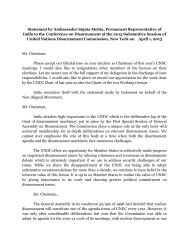
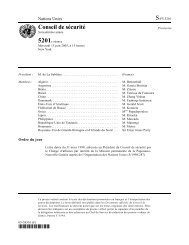
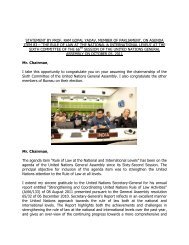

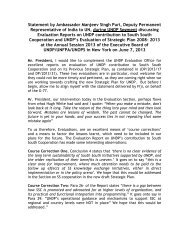
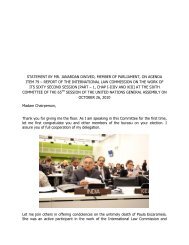
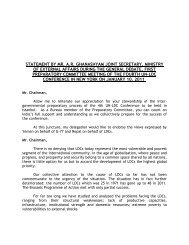
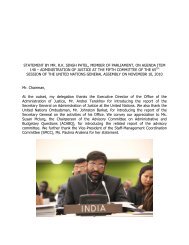

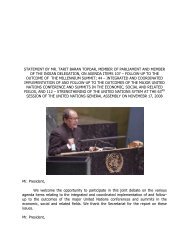
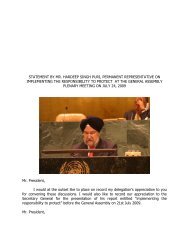
![1 statement by dr.[mrs] kakoli ghosh dastidar - Member States Portal](https://img.yumpu.com/27526598/1/190x245/1-statement-by-drmrs-kakoli-ghosh-dastidar-member-states-portal.jpg?quality=85)
